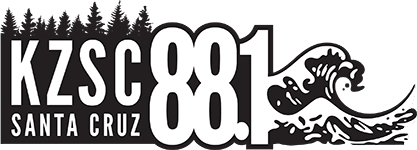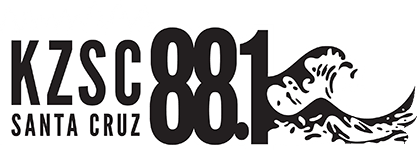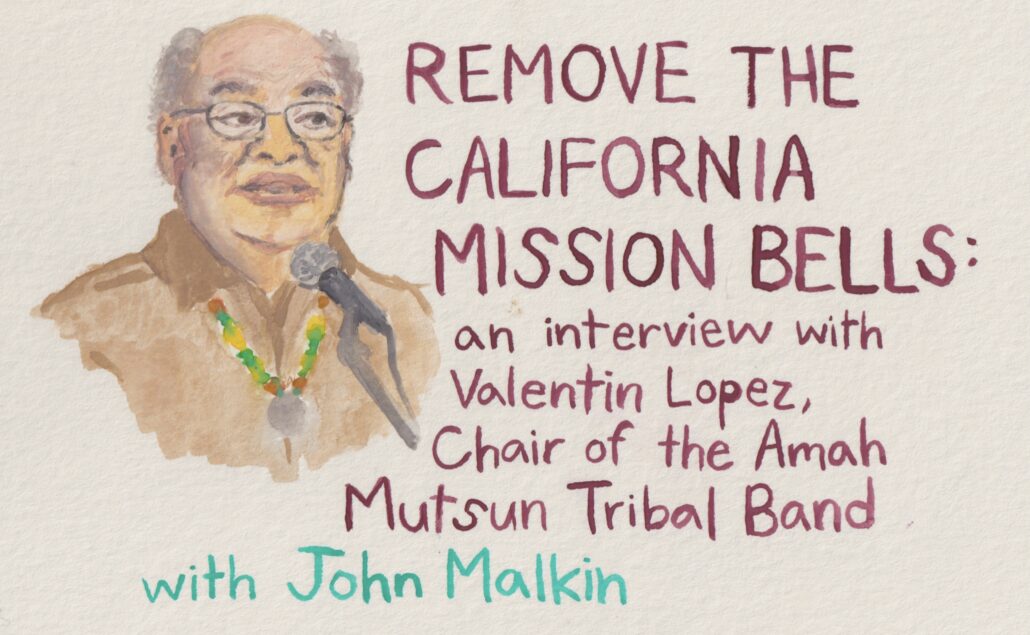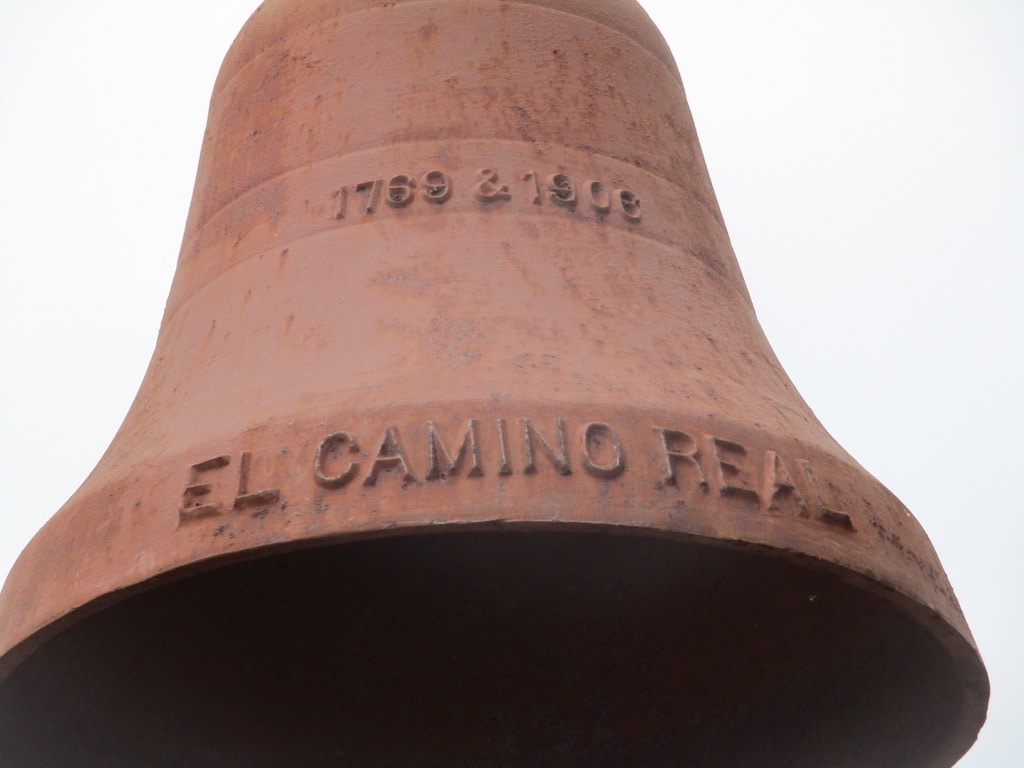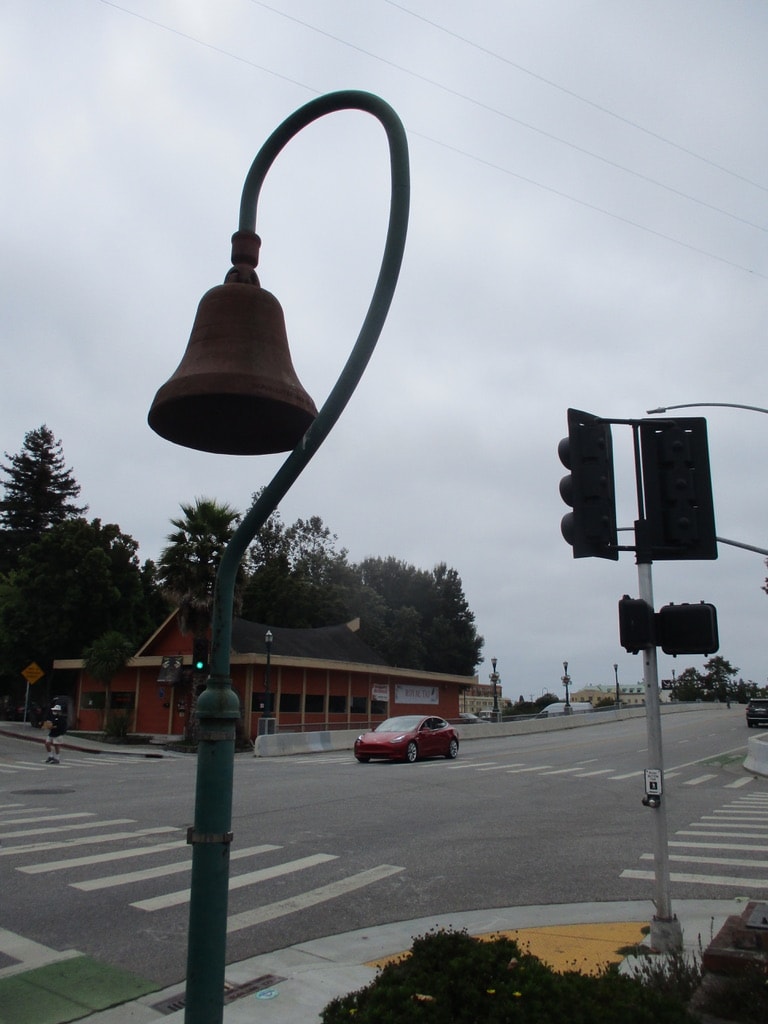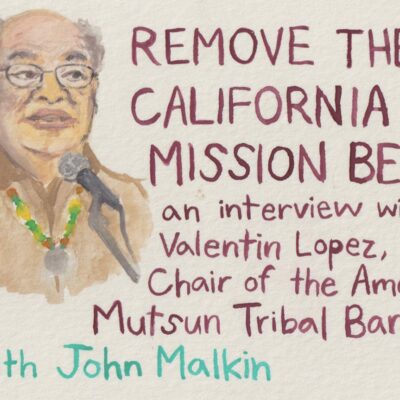
Art by Hannah Rouland, @hannah.tor.art
Remove the California Mission Bells:
An Interview with Valentin Lopez, Chair of the Amah Mutsun Tribal Band
August 23, 2021
Santa Cruz, California is the first city in the state to remove the El Camino Real bells that were placed here in the early 1900’s. Hundreds of these tall bell markers line what is now Highway 101, up California’s beautiful coastline. The bells were originally placed to encourage people to travel around California via automobile, which had recently become available, and visit Catholic Missions from San Diego to San Francisco. The bells were meant to symbolize what was a fictitious symbiotic relationship between the Spanish conquesters and the dozens of indigenous tribes that they enslaved and brutally forced to convert to Christianity. Twenty-one Spanish missions were founded between 1769 and 1833.
Mission Santa Cruz was founded on Aug. 28, 1791 and three mission bells were later placed in the city limits. In 2019 Valentin Lopez, chair of the Amah Mutsun Tribal Band, contacted the city to ask that all three bells be removed.
In 2019 the bell located on the campus of the University of California at Santa Cruz was removed. The second mission bell was removed by activists during a Black Lives Matter march on June 11, 2020. In November, 2020 The Santa Cruz Historic Preservation Commission unanimously passed a recommendation to the City Council to remove the one remaining mission bell which is located at the corner of Soquel and Dakota Avenues in downtown Santa Cruz.
At the time, Santa Cruz Director of Parks and Recreation Tony Elliot said that the bells represented the genocide of the local native population.
More information about the brutal history of the Spanish missions, local indigenous rebellion against the Spanish and the movement to remove the bells is available online at HYPERLINK “https://removethebells.org/” https://removethebells.org/ and HYPERLINK “https://www.parks.ca.gov/virtualbellexhibit” https://www.parks.ca.gov/virtualbellexhibit
A ceremony to remove the final bell in Santa Cruz is being held on Saturday August 28th at 1:00 PM at Mission Plaza Park. At 3:00 PM there will be a one-mile procession to the location of the bell, at the corner of Soquel and Dakota, where the bell will be removed. The days events will be livestreamed.
The ceremony is being hosted by the Amah Mutsun tribal band and speakers at will include local historian Martin Rizzo, mayor Donna Meyers and representatives from the Esselen, Ohlone, Tataviam, Amah Mutsun and other local tribes. Valentin Lopez, chair of the Amah Mutsun Tribal Band will be a featured speaker as well.
This interview was originally broadcast on “Transformation Highway” with John Malkin on August 26, 2021 on KZSC 88.1 FM / kzsc.org.
Photo of the last mission bell in Santa Cruz, days before its planned removal by Valentin Lopez and the Amah Mustun Tribal Band. (photos: John Malkin)
THAT HISTORY IS AN ABSOLUTE LIE
JM: “I’d love for you to talk about the mission bells and what they represent and why they were put up and why you’d like to be taking them down. Of course, I noticed in 2019 when the bell at UCSC was removed. And then in 2020, when during a Black Lives Matter march, the bell at the Santa Cruz mission was removed. Tell me a little about the bells and what they represent and why they were put up.”
Valentin Lopez (Chair of Amah Mutsun Tribal Band): “Well, the mission bells are meant to recognize the history of the missions in California. But that history has never been truthfully told. The way it’s presented is that it was a loving, peaceful time and the Indians came to the missions voluntarily. They came to find a better life and to learn agriculture. And they came to find God. That story there, that history, is an absolute lie. And we’re saying that we’re going to insist that the true history of the California mission period, and the true history of the other California periods – the Mexican period and the California American periods – we want that history to be told as well.
When people learn about the history of California, it all starts with the missions. As if that’s when the Indians came into existence. But the indigenous people of California, the California Indians, all that started 15,000 or 20,000 years ago or more. As we say, it’s been since time immemorial that we’ve been here. And that history has never been told. We’ve never been looked at as human beings and we’re never looked at as having any purpose or benefit. We’ve been compared to just another species of wildlife here in California. The treatment of the Indians has been horrible.
When I talk about the mission history, I always say that the history of the missions did not start when the Spanish came in 1769. The history of the mission period started in 1453 when the Pope Alexander, I believe it was, issued the papal bull that said all these indigenous people are heathens, pagans, and savages. He said that indigenous people have no soul. And that’s a really important one. Because if you have no soul, you’re not a human being. The church does not recognize you as a human being if you do not have a soul. That’s what makes human beings different from everything else. So, since we didn’t have a soul, they thought we were not human beings so they could enslave us, kill us, rape us, torture us and do whatever they want. And it wasn’t a sin. The papal bulls also said that all indigenous people are the enemies of Jesus Christ. That the indigenous people should be put into perpetual slavery and that the property and the possessions of the indigenous people should be taken from them. When you take a look at the history of all indigenous people around the world, that is exactly what happened.
Then, in 1493, there was another papal bull issued. And that papal bull was known as the Doctrine of Discovery. Now at this time, they’re making a lot of discoveries of other lands and other places in the world that were new and unknown to them, to their world. And the pope and the European nations wanted to make sure that they claimed those nations and those lands to be under the jurisdiction and the authority of the country that made that discovery. And also, that those people – the indigenous people – were forced to assimilate into the Catholic religion and become Christians. The papal bull also said that if the indigenous people refuse to that conversion, to be the citizens of that country and to be Christians, that they were to be killed. That’s a directive from the pope; that indigenous people were to be killed if they did not accept that conversion.
And that’s what they did around the world, first to Africa where they captured Blacks and sold him into slavery. There was no moral consideration at all about what does that mean? How does that affect their soul? And then also, they went to India and then they went to Indonesia, the Philippines and then to the Americas. They came to California in 1769. By that time, they had already perfected the best ways to force that conversion, to become a citizen of Spain and to become Christians. And that was the mission system. With the mission system there was enslavement. Indians did not go to the missions voluntarily and they did not go there to find a better life, to find God and to learn agriculture.
Indians had a very long history of governance. They had a strong culture and very strong spiritual beliefs. And yet they were looked at as not being human beings by the pope. One more thing about the papal bulls; in 1823 there’s a Supreme Court decision referred to as the Macintosh decision. The Macintosh decision says that the Doctrine of Discovery is the law of the land for the United States. It was the foundation of the land use laws in the United States. Let’s remember, the Doctrine of Discovery says if that people don’t assimilate, they would be killed. And that’s why all the Indian massacres, the killings of the Indians, is because the Indians were not seen as human beings according to the church and the European countries that were doing the conquest or the discoveries. That’s a really important part of the history that’s never told.”
THAT BELL WAS MEANT TO CONTROL THEM
Valentin Lopez: “And so now back to the mission bells. You know, whenever they would build a mission, they always had a bell there. And that bell was meant to control them. It would ring in the morning when it’s time to get up. It would ring when it was time to go to work. It would ring when it was time to break for lunch and dinnertime. It would ring when it was time for them to say prayers. They were controlled by those bells. It’s just a way of controlling and dominating the California Indians.
And then in 1910, that’s when the automobile is coming out. They wanted to really do a lot to promote California tourism. So that’s when they developed those mission bells as a sign to come and visit the mission bells and learn the history of the missions and see how beautiful and peaceful these places were. And see how wonderful it was for the Indians to come to this peaceful, happy place. It doesn’t talk about San Juan Batista, the mission that I descend from, where 19,421 Indians died as of 1823. And there was still another 10 years of the mission period to go. There’s a lot more death than that in that one mission. They didn’t talk about the eighty-four different tribes that were taken to San Juan Batista mission, and just about all of those tribes today are extinct.”
Photo of the last mission bell in Santa Cruz, days before its planned removal by Valentin Lopez and the Amah Mustun Tribal Band. (photos: John Malkin)
SANTA CRUZ: MOST BRUTAL OF ALL MISSIONS
Valentin Lopez: “Santa Cruz was the most brutal of all missions. The Indians who went to the mission in Santa Cruz had a life expectancy in that was less than two years. There was a father there – Father Quintana – he was very sadistic. He would just beat the Indians mercilessly. And then, one time he got his whip and he started putting barbs on the whip. Like barbed wire. So, whenever he whipped the Indians it would tear their flesh. He was just putting fear and terror into them. Right after he started using that whip, the Indians killed him. And they also removed his testicles, interestingly. Because it’s reported that he also would sexually abuse the Indians. They say that one of the reasons the Indians killed him is that he raped the wife of a Chief that had been brought in. And he did that to show power and domination over that Chief and over that Indian. These are stories of the Indians that are never told.
So then they wanted to promote these bells in 1910 to make the missions these wonderful places and continue telling you a false history of false lies about how beautiful, peaceful and loving the missions were. Our tribe (Amah Mutsun) said, “No, we won’t allow that. The truth has got to be told about this.” And that’s why we have this campaign now to remove the bells. Not only in Santa Cruz, but all the mission bells on state lands in California. As you probably know, those mission bells are pretty prevalent on the El Camino Real, which is now known as Highway 101. You know, they have mission bells every mile, mile and a half, on both sides of the road. Just to glorify the mission period and a false history. And to talk about the wonderful people who first came to California to settle it. And we’re not going to let that happen.”
PERPETUAL SLAVERY
Valentin Lopez: “We’re going to have a strong event, a large event, in Santa Cruz on August 28th and then remove the bell there. We’re going to continue that campaign in California until all the bells on government property are removed. We’re going to go to the state of California and get them to remove the bells on the El Camino Real. And then try to get other communities to remove the mission bells that are in their city limits, that are on public property. It’s wrong to give us a constant reminder every mile, every mile and a half, that our culture was destroyed, that our spirituality was destroyed, that our environment was destroyed. That we were worthless and had no soul. And that we were the enemies of Christ. And we were nothing but savages that needed to be put into perpetual slavery. That history is not going to continue; it must not continue. And that’s what the effort to remove the bells is about.”
JM: “The last mission bell in Santa Cruz is going to be removed. Is that bell up at the mission or the church?”
Valentin Lopez: “It is actually on the corner of Soquel Avenue and Dakota, in front of the bar and restaurant known as Hindquarters. There’s a bell right there on public property. And so, we’re going to have it removed. Santa Cruz had three bells; one on the UCSC campus, one at Mission Plaza, which was taken down. And the third one is at Soquel and Dakota.”
JM: “For many years, there have been some movements to remove these kinds of symbols. And it’s increased during the last two years since the pandemic started and then George Floyd and a lot of other brown and black people were killed by police. The Black Lives Matter movement and other social justice movements have really expanded hugely, and there are more people now it seems around the world, calling for this kind of action to remove symbols of slavery, genocide, brutality.
Earlier this year, in February, there were discussions about removing a statue of George Washington from the park in Watsonville. George Washington owned a lot of slaves. So, the discussion was about removing that statue. It was quite a heated debate, with some arguing that if you remove the statue of the slave owner president, that people will forget that history. The committee decided to remove the statue, but put it somewhere like a library or a museum with a plaque explaining the history of George Washington and his participation in slavery. What do you think about this argument, that if we remove these symbols, like the bells, that it removes the history?”
Valentin Lopez: “Well, we’ve been talking to the city of Santa Cruz, as you probably know. They’re going to find a museum to put this bell in there. And they’re going to talk about the history of the bells and our opposition to the bell. And they’re going to talk about the tribal people here and what the impact of the missions was on our tribe and all of the California tribes. They’re going to tell the truth. Those symbols will be used to tell the truth and not to glorify or to honor those perpetrators. We’re okay with that, at least for the mission bells. For the other ones, like George Washington, others are going to have to decide how they see best. But for the mission bells, this is what we’re asking for.”
JM: “I also think about this huge statue of Junipero Serra that’s up towards San Francisco with him pointing down at the ground. I don’t know if there’s any movement to remove that?”
Valentin Lopez: “We have written letters about that and we’d like to start a campaign on that. But that’s not our territory. And so, we can’t speak for other tribe’s territory. And that’s what’s happening there.”
JM: “As you mentioned, these bells extend all the way down California along the El Camino Real, Hwy 101. Is Santa Cruz the first place to remove bells?”
Valentin Lopez: “Santa Cruz is the first city in California to be removing the bells. Yes.”
A RESPECTFUL WAY
JM: “So tell me, how cooperative have city council people and other people in Santa Cruz been about removing the bells?”
Valentin Lopez: “The City of Santa Cruz has been very supportive. They passed the resolution to approve the removal of the bells by a unanimous vote. So, the city of Santa Cruz, as I said, is very supportive. We first met with the city in 2017 or 2018, to talk about the removal of the bells. What’s going to happen on August 28th is a long time coming in that regard, because we started talking about it a while back. But then we had the fires and the flu. And we had to have a number of meetings with council members and staff, etc. They had to do research on how the bells came about and who supported them and let them know about our efforts to take them down. And to see how they felt about it. So, it took a while to get to where the city was comfortable in approving the removal of the bells. We wanted to do it that way versus a protest or just ripping down the bells. Our elders have directed us that really, we’re not allowed to do that. We have to do it in a respectful way. And so that’s what we’re doing.”
HOW HEALTHY IS THE STATE?
JM: “It sounds good to have a ceremony that people can come to and participate in and it can be something that involves the community and involves music and involves a kind of grieving in a way, about this history. And it’s an action to recognize that this history is really awful.”
Valentin Lopez: “It is awful. It is. And you know, this is not the only event that’s happening in Santa Cruz regarding the missions. On August 27, the Friday before, there is an event happening at the mission. Janet Napolitano, who was the president of the University of California system, for the past two years she gave a million dollar grant to study the true history of the missions. With that million dollar grant, they gave Indians smaller grants for research and to get the information out to the public. And that two-year research period is coming to an end now. So, there’s ‘gonna be a conference in Northern California and a conference in Southern California. On August 27th, that’s going to be the conference for Northern California. So, a lot of scholars are going to come in the day before and talk about the true history of the mission and its impact – short and long-term impacts. We’ll be talking about a lot of different elements about the history. Some of those speakers will talk at our event as well on the mission period. It’s time for the truth to be told. It’s going to make a lot of people uncomfortable; we know that. But our tribe has been working on tribal wellness going on thirteen years now.”
PERPETRATORS HAVE MORE HEALING
Valentin Lopez: “One thing that we talked about is how to have healthy relationships. To have a healthy relationship takes two healthy people, two healthy partners or two healthy entities. But how healthy is the state of California if they can’t tell the truth about our history? How healthy are the cities and the counties if they can’t tell the true history of California Indians in the school system? They continue to allow our sacred and cultural sites to be destroyed for development. How healthy are they? How healthy are they if they ignore the history and put their feet on the ground every morning when they wake up, on land that was stolen from the indigenous people? They just ignore that and don’t acknowledge that. How healthy are they? So, if people want healthy relationships with indigenous people, they have to recognize that they have a lot of healing to do, too. Perpetrators have probably more healing to do then the indigenous people do. They’re the ones that were responsible for those atrocious acts and they must heal from that. And until they heal from it, we’re not interested in having a relationship with them. That goes down another path. But that’s another part of this. Moving the mission bells is part of a healing process. A very important healing process. And we have to acknowledge that.”
JM: “It’s really a deeper part of this process. The bells are very symbolic, but there’s the healing of the perpetrators and those of us who have come since the perpetrators; we need to participate in healing our culture. And there’s the healing also of the people who suffered; that all has to happen. When I’m hearing you talk about that, I’m wondering if you have looked at other places on the planet where similar things have happened? Unfortunately, there’s lots of examples. Other places where there’s been genocide and slavery and religious tyranny. If you’ve found places where they’ve done this well, and you can kind of model it on that? Sometimes people talk about South Africa and their truth and reconciliation program, which I’m not sure how well that actually went. And one could talk about how well, or not well, people in Germany have learned about, and coped with, the history of Nazism and the genocide there. I don’t know if you’ve learned anything from other experiments with healing from this kind of pain?”
Valentin Lopez: “Well, let me say something first. You said that you felt that you came after those atrocities. And, therefore, “I wasn’t part of it.” Therefore, “I have no responsibility to it.” You didn’t say that. But, too many times that’s the thinking there; “I wasn’t part of it, so I’m good.” But what we say is that; perhaps you weren’t there collecting bounty money. Or paying bounty money, or participating in expeditions to exterminate Indians. Or enslaving or raping Indians. But you have to recognize that you benefit greatly from that history. You benefit greatly. Every day you put your feet on ground that is stolen. And every day you’re riding your car on roads that were paved over village sites, sacred sites, prayer sites, fishing sites, hunting sites. There’s no thought to the indigenous people that were here before. We know it’s not your responsibility. But what we ask, and this goes along with the healing, we ask that all people recognize how they’ve benefited greatly from that period.
Today, the indigenous people are asking you to help us restore our culture, our indigenous knowledge, our spirituality and our ways of taking care of Mother Earth. To work with us and help us. And our help is going to be critically important if we’re going to be successful in dealing with climate change, for example. Because our people took care of Mother Earth for all those years. They know how to take care of Mother Earth in a very sustainable way. When the colonizers came, they thought we had no knowledge and nothing to contribute. But a lot of research going on now – our tribe does a lot of research – and finding that the ways of our ancestors is the way we need to take care of the planet going forward. It makes sense. So, we’re asking the public to work with us and work with other tribes so that we can work together to heal mother earth.”

NO SUCH THING AS RECONCILIATION
Valentin Lopez: “That’s one thing. Now the other part of the healing is talking about the atrocities. I never approved of what happened in South Africa. There was an effort to do the same thing in Canada; truth and reconciliation. There is no such thing as reconciliation. What does reconciliation mean? When you reconcile, it’s when you take a relationship back to a time when it was good. Like a married couple, you know. They get married and two, three years pass and pretty soon they’re bickering and they get short tempered with each other and they start saying things and not being as discrete. And pretty soon they’re at odds and they say, “Wait a minute. Let’s reconcile. Let’s bring it back to when times were good.” Our relationship with the church and state of California or the federal government; when was that relationship ever good? It was never good. There’s nothing for us to reconcile back. For us the word reconciliation; we’re not interested in that. It’s somebody trying to feel good. It means nothing. We don’t accept apologies, either. When we hear apologies that just means, “We apologize. Now will you shut up?” That’s all we hear.
In 2015 Pope Francis, in Ecuador, he apologized to the indigenous peoples of the Americas for the sins and offenses of the church. We wrote the pope a letter and we said, “We do not accept your apology.” I learned that as a Catholic, when I was very young, that to be forgiven for your sins you have to confess your sins. Wholly and completely. Then you have to do penance and you have atone for your sins. If I was to go into a confessional booth for confession and say, “I’m sorry. I apologize.” That priest would not forgive my sins. He’d say, “Well, you have to tell us what you did. Why did you do it? How many times, etc.” But why does a church expect to give an apology? Or the state of California? Governor Newsom did the same; he gave an apology. They don’t say what they did. They want to give an apology and have it pass. We’re not going to accept that. That’s off the mark.
Finally, I will try one more time to answer your question! (laughter) Truth and reconciliation, we don’t accept that. That was meaningless. And what they did in Germany. You know, there’s laws and books and stuff like that where you can’t deny the truth. And there’s mandatory teaching in schools. And they have roadside markers for some of the events there. I don’t know that history real well. But I know, at least it was an attempt and it went much further than they have on any indigenous histories that I know of. So, we’re not looking to learn from that. We see other examples of efforts and most of them fall very short.”
JM: “Yeah, I think so too. I think it was about ten years ago when people in Santa Cruz marched from Grant Street Park to this large meadow that ended up being called the Knoll and there was this movement to Save the Knoll. A national house building corporation started digging there, preparing to build a bunch of houses at the end of Market Street near Isbel Drive. And as they were digging, they found remains of an indigenous boy, probably 3000 years old. And the building stopped temporarily. I went on a few marches there and recorded interviews and did some radio then and I’m pretty sure you must have been there. That happens occasionally in Santa Cruz. I think it happened again just last week at Santa Cruz High School where some human remains were discovered. I don’t know if you want to say something about that. At the Knoll site, they eventually built all these houses anyway, which was kind of disappointing. I don’t know if you have anything to say about about this?”
THE VALUE OF AN INDIAN LIFE
Valentin Lopez: “That happens a lot for all indigenous tribes. I can remember one time when they were building a Safeway Market and they uncovered an Indian gravesite. 188 Indians, or bodies, were removed and we had to do a reburial of them somewhere else. That was such a horrible feeling. 188. All for a Safeway supermarket. You know, what’s the value of an Indian life? What is the value of Indian history? What is the value of indigenous peoples? There is no value. It’s an inconvenience. They just want to move it out of the way so they can make their money. So, we’re aware of Santa Cruz and we’re working with some authorities there. But we don’t talk about that because it’s important that we keep it confidential because so many times people will hear about things like that and they’ll go and try to dig it up and see if they can find some stuff they can sell on the Internet. So, we try to keep all that stuff real quiet.”
JM: “I’m really grateful for your persistence and honesty and your efforts. And if you have anything more you want to say about the bell removal ceremony, or anything else, please do.
Valentin Lopez: “We ask the public to join us. It’s going to be available on Facebook Live. They can stream it there. So, people can join it. We’re thankful for your article, because we hope it gets really good coverage. And we need to put pressure on the state of California to take steps to get those bells removed. That’s about it.”
